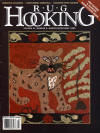
Rug Hooking
Volume XI, Number 5
March/April/May 2000 |
IRISES
When Peggy Hannum
tried hooking more than 20 years ago, she did it
only to please a friend she was visiting who had
recently begun hooking and insisted Peggy try
it. But Peggy's the one who ended up being
pleased by the fiber art. "I couldn't believe
the wonderful range of colors and possibilities
inherent in the dye pot," she recalls. "[My
friend Lyn] had uncorked a veritable genie's
bottle." Peggy's choice of pattern for her first
rug—the 54" x 37" Irises—was ambitious, but she
was determined to hook it. She dutifully
found a teacher near her Danvers, Massachusetts,
home (Meredith LeBeau) and headed off to class
with her pattern. "Meredith soon ascertained
that I knew next to nothing about hooking and
even less concerning dyeing," Peggy says, "and
offered that most beginning students started
with a small piece, a nice little round rose,
perhaps.... I'm sure she saw my disappointment
and probably couldn't miss the edge of a whine
in my [wistful plea], 'But I really love
irises.[Meredith] looked at the rug and at me,
took a deep breath, smiled, and said, 'Then
irises it shall be.' With her guidance, I was
able to dye all my own wool, experimenting with
novelty dyeing, jar dyeing, and spot [dyeing]."
As Peggy worked on her rug, she learned how to
hook strap leaves and, of course, irises. "I
have done a great deal of hooking since then,"
she says, "but Irises is still my favorite rug.
Thanks to Meredith's willingness to listen to
her student and her sensitivity to what was
important to [this] learner, I have been able to
find years of enjoyment and growth in the art."
(go
back up) |
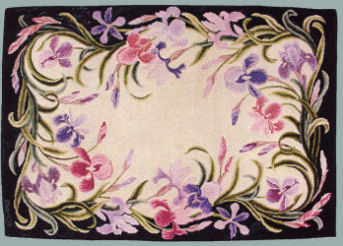
Irises,
54" x 37", #3-cut wool on burlap.
Designed by Heirloom Rugs.
Hooked by Peggy Hannum, Lancaster, Pennsylvania,
1979.
Photograph by Impact Xpozures. |
| |
| |
| |
|
|
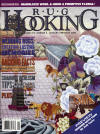
Rug Hooking
Volume XIV,
Number 4
January/February 2003 |
Peggy Hannum our
teacher from Lancaster, does mostly fine
hooking. She is a certified McGown teacher and
also gives lessons in her home. Peggy loves to
dye wool, and everyone is amazed at the
beautiful results she brings to our meetings.
She is very helpful with her advice and shares
with us a great many ideas. Peggy's kits are
marvels of color planning, and her directions
are always easy to follow. She is always willing
to offer personal help if it is needed
(Peggy’s rug, Silver Compote, is featured
in A Celebration of Hand-Hooked Rugs, XII.) |
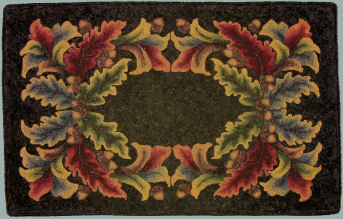
Oak
Scrollings
36"
x 24",
#3-cut wool on rug warp
Designed by Jane McGown Flynn.
Hooked by Peggy Hannum, Lancaster, Pennsylvania,
2002
(go
back up) |
|
|
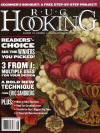
Rug Hooking
Volume XV,
Number 1
June/July/August 2003 |
"Silver Compote"
Upon looking at
Peggy Hannum's lovely rug and noticing its name,
an obvious question comes to mind: Why is tins
Silver Compote gold? As Peggy easily explains,
the answer lies in the frame. On one of Peggy's
antiquing forays several years ago, she came
across a lovely gold-leaf frame in fairly good
condition. At the time, Peggy had no hooked
piece for it, so the frame sat in her workroom
for three years. Later, white cleaning,
she found some old patterns a student had given
her, and there she found Silver Compote. This
piece was just what Peggy was looking
for—something with fruit and flowers— and it was
the exact size of her lonely frame. The only
change she would need was to make the silver
bowl gold. At Laurel Mountain Rug Camp,
teacher Nancy Blood worked her magic with the
color plan and the formulas. With Nancy's
expertise, the project got off to a flying
start, and Peggy had nearly completed the rug by
late summer 2001.
"I thought it
would be finished in no time, so I took it on
vacation with me to my son's home in Maine,"
says Peggy. Once there, she hit the proverbial
snag. All that was left to hook was the
table, but Peg soon discovered that the
background and table, both being dark, blended
one another, and the table just disappeared! She
and her son Bob, an artist, worked out the
problem by using lighter shades of the
background spot-dye subtly against the
button-holed, darker edge of the table. "The
effect we wanted to achieve was that a table was
there, but not obviously so, and it worked,"
says Peggy. Peggy's Silver Compote now has a
gold bowl that perfectly matches its gold-leaf
frame. The elegant wallhanging graces the
Hannum's dining room wall. Peggy admits
that, almost all of her rugs are hooked with #3
or 4 cuts, as she enjoys fine shading. Many of
her students, however, hook primitives. "I
actually have a few wide cuts in the works,
although they say my definition of a primitive
is somewhere between a #4 and 5 cut," laughs
Peggy. Someday, with a little help from her
friends, Peggy says she may get the hang of it.
(go
back up) |
COMMERCIAL
DESIGNS OR ADAPTATIONS
First Place |
Silver Compote
Margaret "Peggy" Hannum, Lancaster, Pa. |
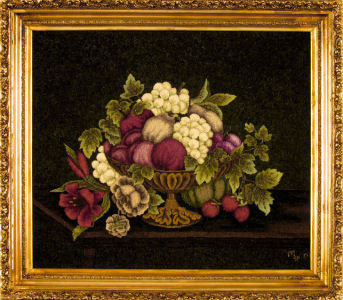
Silver
Compote
26 1/2" x 22 1/2",
#3-cut wool on burlap
Designed by Charlotte Stratton
Hooked by Peggy Hannum, Lancaster, Pennsylvania,
2001 |
| |
| |
| |
|
|
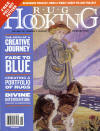
Rug Hooking
Volume
XVI, Number 4
January/February 2005 |
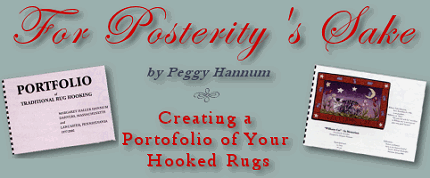 |
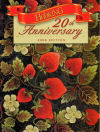
Rug Hooking
20th Anniversary
2008
Edition |
|
|
Most rug hookers
have photo albums documenting their rugs with
dates, pictures, and appropriate information.
Having put so much time and creativity into
producing each piece, large or small, I wanted
some tangible evidence or remembrance of each
creation. Every now and again someone will ask
me if I have sold any of my rugs. My rather
shocked response has been, "No, and I haven't
sold any of my children either!" Many of you
have generously dispersed your rugs among family
and friends from one corner of the country to
the other. Each time I hear one of my students
or hooking friends exclaim: "This one is for my
son," or "I promised this to my dear friend," I
cringe. Until two years ago, I had not parted
with anything.
I have been hooking for 28 years, and until I retired seven years
ago, it took me an average of two or three
years, and in one case, seven, to finish a rug.
At that rate, the hooked piece has become an
integral part of the family and is not about to
leave the nest without some kind of "empty rug
syndrome." Now that I am retired, I find that I
am able to hook two or three fairly large rugs
per year. I am basically a night person and try
to do some hooking each evening. It amazes me
how much can be accomplished between 8 and 11:30
p.m. If I am too tired to concentrate on "that
turnover" or "those bird feathers," I do
background. And there is always background!
The
Decision is Made
I have come to the point that I am hooking rugs
because I want to see what can be achieved with
color and form, not because I am trying to
create a spot of beauty on a particular space of
floor or wall. In that respect, I have reached
"critical mass." "The thought of giving some of
my cre- ations away to my family surfaced
recently
when I decided to draw and hook a rug featuring
my grandson William's cat. I held on to it for a
year or so, putting it in various rug shows. But
having run out of those, I faced the fact that
perhaps I really should part with it, and long
overdue, gave the rug to William for Christmas.
Having finally made the decision to give up one of my "children"
for adoption, whole new scenarios presented
themselves.
I began thinking about the
Chinese
Butterflies rug that I had promised to my
granddaughter when she graduates from college
and has her own apartment or home. At one time
that seemed a distant and safe horizon, but she
graduates this spring, and I can see those
Chinese butterflies taking wing as well. Then
there are possible rugs for my sons and
daughter, and I certainly don't have the excuse
that, "Oh well, my daughter-in-law would
probably put it in the garage." They all value
my rugs as much as I do. My only lingering
regret was that once they were gone, they were
gone. I had an album of photographs, but some-
how that didn't seem to have the permanence I
wanted.
The
Light Bulb Moment
Synergy does affect life, and things have a way
of happening simultaneously. Two summers ago we
were vacationing in Maine with our son, Bob, and
his family at the home of David, one of his
college friends. David's avocation is
painting and he displays his works in a gallery
near his home in Santa Fe. He shared his
portfolios with me, which were quite impressive
and professionally done. This was the answer to
my need to have a lasting illustration and
record of my rugs before they were dispersed. My
thought was that it would be wonderful to have
something of this quality in which to display my
own artwork, but I thought it would be out of my
price range.
The
Details
The process of creating a portfolio is not
difficult or any more expensive
than the cost of
attending a rug camp or doing a large rug. By
far the greatest expense was in the photography.
Between 1977, when I started hooking, and 2002
when I decided to do a portfolio, I had
completed 19 rugs and large pieces. If I
included a first page dedication to my teachers,
Meredith LeBeau and Nancy Blood, along with the
nineteen color plates, I would have a nice sized
booklet.
The cost of having rugs
professionally photographed is in the range of
$25 to $35 each. Since I chose to have someone
else do my photography, I was fortunate to live
close to Bill Bishop, who does the
photography
work for Rug Hooking magazine. I was able to
take all of my pieces to his
studio where they
could be hung on a wall to be photographed. I
would refer readers to the excellent article in
A Celebration of Hand-Hooked Rugs XIV, "Picture
Perfect," in which Bill gives step-by-step
instructions on how to take your own
professional photographs. Even if many of your
rugs have been packed off to family or friends,
it is no longer a great task to have them
photograph the rug and send you prints. Perhaps
you could even first send them a copy of Bill's
article to ensure the pictures will be of high
quality.
|
I would refer
readers to the excellent article in A
Celebration of Hand-Hooked Rugs XIV, "Picture
Perfect," in which Bill gives step-by-step
instructions on how to take your own
professional photographs. Even if many of your
rugs have been packed off to family or friends,
it is no longer a great task to have them
photograph the rug and send you prints. Perhaps
you could even first send them a copy of Bill's
article to ensure the pictures will be of high
quality.
The next
step after deciding who will do the photography
is to find a copying service. I used Sir Speedy;
David had used Kinko any will probably be
comparably priced. To
my good luck, what I found at Sir Speedy was a
willing staff.
They were very
helpful even to the point of speaking by
phone to the photographer and asking him to put
the photos on a disk, which they then can put
into their computers to be printed. Being a
neophyte in both photography and computers, I
had no idea of what was what or where to begin.
The staff at Sir Speedy took the project and me
in hand.
Bill Bishop sent me proofs of the
photos that 1 laid out on 8 V2" x 11" print
sized paper and then hand printed, cut, and
pasted my copy for each rug, page by page. I
decided that each picture would be 5" x 7", but
you can make them any size. Sir Speedy set up
and typed the final copy. My son has an art
background and suggested not using the same
layout on each page, but positioning the
pictures and texts differently. It was good
advice, as visually each page varied.
The
layouts were done more hurriedly than I wanted,
because I decided the portfolios would be nice
Christmas gifts for my family and for that
purpose decided to have 10 copies made. For most
pages I had three brief texts positioned
differently on each page: one with the name of
the rug, the size and the designer; a second
indicating whether the wool was hand dyed, the
kind of backing, the cut of the wool, and the
year the rug was completed. In a third blurb I
listed any publications in which the rug
appeared and awards it had received and lastly,
if appropriate, a brief note about the
rug's inspiration. In retrospect, I would have
added when I started the rug as well as the date
it was finished. I find that one of the
questions I am most often asked about a rug is:
"How long did it take you to do this?"
Other choices you need to make include the weight, for the
paper, kind of font for your type, and how
you wish to arrange your text on the
pages. I chose a good paper weight, 65 Ib.
for the text, and a slightly heavier
weight, 80 to 100 Ib., for the cover.
There will be a variety of tints and paper types
for your cover ranging in price, but I chose the
least expensive in a pale tint that, I felt was
tasteful. Since my rugs are more formal in their
design and execution, I chose a simple type
using the same font throughout, bold on the
cover, and others varying in size but the same
throughout. If you look at the covers of Rug
Hooking and Celebration, you will see a
combination of simple and fancy types. Either
works well and it is a matter of what you feel
best complements your type of hooking.
For the binding I chose a simple spiral plastic binding which
allows the book to open and lie flat, and also
it was provided at no additional cost. I would
probably make a few minor changes in the
placement of text on the pages. The most
important adjustment would be in the arrangement
of the margins. I had not allowed for a larger
margin. on the left, side to accommodate the
spiral binding, so some of the left side text is
almost in the binding. You need to set up
margins on your page BEFORE you do a layout. It
was suggested to me that leaving slightly more
margin space on the bottom of the page than the
top is more pleasing to the eye. (Again, look
carefully at Celebration.') This is a small
thing but adds aesthetically to the look of the
finished product. If you have sold any of your
rugs, another suggestion might be to indicate
this in your text as: "in the collection of ——-"
rather than the less professional presentation
of "sold to—-."
Printing Problems
One of the most important factors in the whole
publishing process was that Sir Speedy did a
proof run before printing all of the copies. I
would not have assumed that they did this, but
it turned out to be critical. The pictures
printed with a decidedly green tint that was not
accept- able to me OR to them. As the young man
who was working with me said, "We want a product
you can be proud of and that we are proud of."
After they conferred with Bill, it was
discovered that the problem was not in the
photography but in the particular copier that
they were using.
Again, I was learning
more than I ever expected to know about the
copy-printing world. Copying services often use
several types of color copiers and some are more
equal than others. They redid the proof, using
a. second copier after they had the machine fine
tuned by their repair service.
|
After the glitches were worked out and another
proof run, all of us were very sat-isfied. If you decide to do
a second or sub- sequent reprinting as I did, be
sure to ask for a proof as I ran into the same
situation several months later with the green
tint. Again, remember that there are
multiple copiers at each business place, and
they need to achieve the acceptable color before
printing all of your books.
Many of your choices will be your per- sonal preference, but I was
not aware of how many there are for the taking.
Since I was looking for the most economical way
of producing a booklet, I only worked with
printers. However, there are also designers that
can do an artistic job of arranging and doing
your layout before you take it. to the printer.
I was looking for a Ford rather than a Cadillac,
but discovered that there are some pretty classy
little economy jobs out there.
A portfolio can be as inexpensive or elaborate as you want to make
it. I have updated current costs at Sir
Speedy—as of September 2004, their initial cost
for the type setting for a. 20-page booklet is
approximately $200. After this one time set, up,
the cost of printing, if you want, 1C) copies of
the portfolio, is $1.24 per page; for 20 copies,
$1.07 per page. The more one prints, the cheaper
the cost per page. It will be possible to add to
this existing volume because of its spiral
binding, but since I've dispersed over 50
copies, that is not an option for me. I have in
mind doing a
second volume when I have accrued
another 15 or so pages. I already have completed
five more pieces since the
portfolio was
printed in 2002.
Behind the Wool
When I was working on this article, we
were vacationing with Bob, and his family
in Maine, so I brought along my portfolio,
which I had done two years ago with some
hurried telephone advice from him at the
time. I asked Bob to sit down with me and
critique my portfolio with an eye to
improving it.
Several issues perhaps more important
than the 'how to' of producing a portfolio
came from this conversation. First of all,
we realized that people are always amazed
at the amount of time it takes to complete
a hooked piece, not just hours, but months
and sometimes years. A lot of living occurs
for us as artists during this time, and each
piece we create not only carries its own
story but also ours.
My hooking hours are my reward to
myself at the end of the day. They are my
quiet time for reflection and creativity. My
rugs all take an immense amount of hours
and life is happening in all this time, and as
my son reminded me, people, not just family, are interested in this. Our rugs and
their stories will be around long after us.
The stories may become even more interesting
than the rugs.
The tale behind the Grenfell rugs of
Nova Scotia is one of those. Being a missionary doctor, Dr. Grenfell attended to the
fishermen and attempted to give the people
another source of income. The silk stockings his wife collected from New York
socialites to make the rugs became unique,
original, and collectable works of art.
When I was hooking Pearl McGown's
TJze Unicorn, in Captivity, I assumed the
drops on the unicorn's coat were blood.
After all, he was chained and fenced and
looked rather doleful. However, after doing
some reading about the original tapestries
that hang in the Metropolitan Museum in
New York, I discovered that the drops were
pomegranate juice from the fruit on the
tree above his head. I had to "rethink" those
oranges that I had hooked on the tree and
do some reverse hooking to make them
pomegranates instead.
Charlotte Stratton's Silver Compote,
which hangs in my dining room, began with
an old gold leaf frame I had found in an
antique shop in New England. The frame
sat in my basement studio for over two
years looking for a picture. I accidentally
found Silver Compote when I was rummaging through a pile of old patterns
someone had left with me quite a few years
before. It was perfect for the frame and has
become one of my favorite pieces.
The reason that the center of
Heirloom's Salem is dated 1993 and the
outside scroll border is dated 2003 is because
we put everything in storage for four years
and went to live in Jerusalem as the
liaisons for the United Methodist Church.
In those years I did no hooking, and it was
10 years before I returned to finish Salem,
mostly because the big upstairs hallway in
our Federal home in New England, for
which I was making it, was no longer part
of our lives. These are all stories that add
to the interest and the provenance of the
rugs.
As fiber artists too often we do not give
enough credit to our art or to the fact that
we ARE artists, painting with wool. Each
kind of hooking—wide-cut, primitive, fine
shading, original or commercial design is an
equally valuable form of our art, just as
Impressionist, Modern, and Classical are all
valuable types of painting. Whether we are
beginners or have been hooking for
decades, our works are unique; they are a
part of us, and our lives, and deserve to be
documented and passed along in a lasting
form.
_________________________________
Peggy Hannum's lovely Lancaster
County, Pennsylvania home and her rug collection were featured in A Celebration of
Hand-Hooked Rugs XIV. Her rug Istanbul
was also a finalist in the Celebration of
Hand-Hooked Rugs XIV competition.
(go
back up)
|
|
|
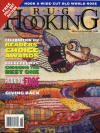
Rug Hooking
Volume XVII,
Number 1
June/July/August 2005
|
"Istanbul"
A retired missionary for the
United Methodist Church, Peggy Hannum and her husband fell in love with the
mysterious and exotic aspects of the Middle East
as they traveled and worked there over the past
20 years; most recently living in Jerusalem as
liaisons for the church. "We also have visited
Istanbul several times in our travels,"
Peggy states. So, it only seemed fitting
that her friend and mentor, Nancy Blood,
would suggest to Peggy several years ago
that she might want to hook the Istanbul
pattern. Then two years ago at the McGown Northern Teachers' Workshop,
where Peggy's roommate, Julie Mayo, was
disposing of some patterns, one of which
was Istanbul, her immediate reaction was,
"The minute I saw it, I knew it had to be!
Too many events had converged."
Once she decided, Peggy sent the
pattern to Nancy Blood to do the
color planning. Because of all the colors
involved and the intricacy of the pattern, it
took Nancy three months to color plan the
rug—beginning in April and finally finishing at the Northern Teachers' Workshop in
July. Nancy sent an array of formulas to
dye—16 different 8-value swatches.
Peggy found the dyeing to be great fun
since she enjoys the dyeing process as
much as the hooking. From there it took
Peggy seven months to complete the rug,
start to finish.
Working with an "all-color" palette, and
intermingling colors and their complements was one of Peggy's favorite parts of
hooking Istanbul, especially since no
motif repeats itself. The most difficult
challenge she encountered was how to
bring definition to the birds' feathers.
Remembering a. technique that, her
teacher, Meredith LeBeau of Danvers,
Massachusetts, taught her many years
ago, Peggy took a thread from a darker
piece of wool and hooked around each
feather giving the illusion of an edge
without it becoming a definite outline.
Peggy, a retired English teacher, has been hooking rugs for
the past 27 years and teaches regular classes in
her studio to over 40 students. Although she has
hooked all types of rugs, she prefers working with the fine-cut #3 and #4. Her rugs
have won numerous awards and have
been featured in Rug Hooking magazine's
A Celebration of Hand-Hooked Rugs I, XI, XII, XIII, and XIV.
(go
back up) |
COMMERCIAL DESIGNS
OR ADAPTATION
Second Place |
Istanbul
Peggy Hannum, Lancaster,
Pennsylvania |
|

Istanbul,
60" round #3- and #4-cut wool on linen.
Designed by Pearl K. McGown.
Hooked by Peggy Hannum, Lancaster, Pennsylvania,
2003. |
|
|
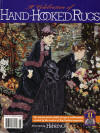
A Celebration of
Hand-Hooked Rugs XI
2001
Edition |

When asked how Chinese Butteries came into being, Margaret Hannum is quite frank.
"Panic is the mother of inspiration," she says. One of her students had selected this
unusual, intricate pattern and asked Margaret to plan and dye it for her. Working with the
design led Margaret to hook it herself.
Margaret knew that color would take center stage in this glorious celebration of
nature's beauty, but didn't feel that her color skills were up to the challenge. So she called
one of her teachers, Nancy Blood, for some thoughts. Nancy suggested that Margaret use transcolor dyeing; read about primary colors in Maryanne Lincoln's book Recipes From
the Dye Kitchen (Rug Hooking magazine, 1999); and experiment with Cushing's Cherry.
Canary, and Peacock dyes. Nancy also encouraged Margaret to use all of the colors in the
butterflies as fine outlines for the Chinese clouds in the border. This would unobtrusively
reinforce the colors in the palette. Working with
these luscious, delicate colors, Margaret says,
was "sheer delight." The first transcolor included
the three primary colors, and after that Margaret
went with any color that struck her fancy. "One
dye just flowed into another to achieve the gossamer fantasy of a Chinese tapestry."
Margaret found that as Chinese Butterflies
took shape, the planning and dyeing were both a
reward and a challenge. "After Nancy's initial,
crucial, advice, I was on my own to plan and
dye." Her own instincts for color, it turned out,
were far better developed than she realized. The
project's successful outcome has increased her
self-confidence far more than she imagined.
"[And so,] a pattern that I had not really chosen
for myself has become the favorite project of [my
23] years [as a hooker.]"
This complex project took only eight months
to plan, dye, and hook. Margaret finished the rug
by overcasting the edges with tapestry wool.
Chinese Butterflies won two awards, Jurors'
Choice and Best Traditional Piece, at a juried
craft show held by the Pennsylvania Guild of
Designer Craftsmen. The rug currently graces
Margaret's bedroom, where its delicate colors
and subject matter are a daily delight. Eventually
it will be given to her granddaughter, who is now
18 and going away to college.
(go
back up) |
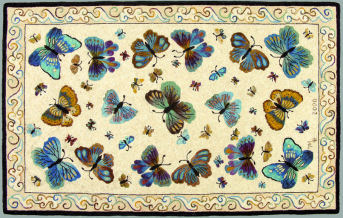
"Chinese
Butterflies"
48" x
30",
#3-cut wool on burlap
Designed by Jane McGown Flynn
Hooked by Peggy Hannum, Lancaster, Pennsylvania,
2000 |
|
Margaret (Peggy) Hannum
Lancaster, Pennsylvania
Margaret Hannum knitted
and sewed, but didn't
discover hooking until a
visit to the Dorr Mill with
her friend Lyn Lovell.
Twenty-three years later,
Margaret is a member of the
Association of Traditional
Hooking Artists and a
certified McGown teacher
whose rugs have won Best
in Show at the McGown
Northern Teachers
Workshops. Margaret, who
teaches classes in her home
in Lancaster, Pennsylvania,
credits Meredith Le Beau
and Nancy Blood as being
teachers and mentors to her.
Their willingness to share
their talents and techniques
have given her the courage
to experiment with color and
design.
|
|
|
|
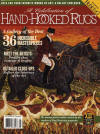
A Celebration of
Hand-Hooked Rugs XII
2002
Edition
|
"Silver Compote"
Peggy Hannum describes her life in hooking as a series of lucky finds, and
Silver
Compote is one of them. Antiquing for interesting old frames to complement her
hooked pieces is one of Peggy's favorite pastimes, and she found this one in a
shop in Massachusetts. For three years, the frame waited patiently in Peggy's workroom
for its occupant.
Then one of her students brought in some old patterns that, she wanted to get rid of.
Peggy's friends and students snatched up most of them, but a few languished on a shelf
until Peggy decided to do some cleaning. "I looked through the little pile of burlap
patterns and unfolded Silver Compote," Peggy says. "Not only was it just what I had
envisioned—something with fruit and flowers—but it was the exact size of my gold-leaf
frame!"
Silver Compote
was a lucky find for another reason as well—Peggy needed a project for the upcoming Laurel Mountain camp. She sent the
pattern off to her teacher, Nancy Blood, who was happy to help
color plan the project, and Peggy began dyeing the wool.
"The colors blend so well because they are a single family of
Triple Over Dyes over different shades of new wool," Peggy
says.
Nancy's expert guidance at Laurel Mountain gave
Silver
Compote a jump-start, but then Peggy hit an unexpected
barrier. "I thought it would be finished in no time because
all that was left was the table, so I took it with me on
vacation. But both the table and the background blended
into each other!" Peggy admits. "This time my son, Bob, was
the 'lucky find.' His avocation is art, and he helped me work
out the problem. As hooking artists, we are indeed painters
with wool." Peggy hooked a slightly lighter shade of the
background spot color against the buttonholed darker edge
of the table, providing a subtle outline without making the
distinction obvious.
The final stroke of luck occurred when
Silver Compote
was framed. One of Peggy's students is now retired from
museum textile work and does custom framing. She
professionally restored the damaged gold leaf and created
a museum-quality framing of Peggy's lucky find. Silver
Compote now hangs proudly in the Hannum dining room.
(go
back up) |

Silver
Compote
26 1/2" x 22 1/2",
#3-cut wool on burlap
Designed by Charlotte Stratton
Hooked by Peggy Hannum, Lancaster, Pennsylvania,
2001 |
|
Margaret (Peggy) Hannum
Lancaster, Pennsylvania
Margaret
Peggy Hannum was
introduced to rug hooking
by Lyn Lovell, who gave her
a copy of Louise Zeiser's
book, Heirloom Patterns.
When she met teacher
Meredith LeBeau in
Danvers, Massachusetts, it
was "the luckiest find in my
life," Peggy admits. "In
addition to hooking, she
taught me how to be a good
teacher." When Peggy
moved to Pennsylvania, she
studied with Nancy Blood,
who taught her color,
design, and dyeing. Two
years ago Peggy received
McGown certification and is
now the national guild
historian. Her rug Chinese
Butterflies was a finalist in
Celebration XI.
|
|
|
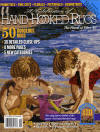
A Celebration of
Hand-Hooked Rugs XIII
2003
Edition |
"Unicorn in
Captivity"
Peggy
Hannum actually
began Unicorn in
Captivity almost 20
years ago. She even took a trip to
New York City to see the actual
tapestry hanging at The Cloisters
at the Metropolitan Museum of Art
because she wanted to duplicate
the color scheme of the original.
Upon arrival, she found that The
Cloisters was closed for renovations. so instead she purchased the poster from the museum gift shop.
Peggy started out by dyeing the wool for the unicorn, the fence, and the pomegranate
tree and in the following years hooked the rug off and on between other projects, finishing
the unicorn and half the fence. She then temporarily put aside her interest in pictorials
and instead hooked other kinds of rug designs. "As it goes with hookers, our projects run
far ahead of our hands, and the unicorn took a very long vacation," Peggy explains. "In the
ensuing years, my husband admired each new finished project, and he would ask, 'When
are you going to finish the unicorn?'"
Peggy finally took the hint last year and picked up the unicorn
again. She had postponed
the project for such a long time. however, that
she had run out of the wool used on the fence
that she dyed almost 20 years before. She still
had the formula, but with the new dyes the
shades were slightly brighter. To resolve the
problem, Peggy wet the original piece and dipped
the new swatch in a
tea bath until it matched.
The experience taught her to keep good notes on
dye formulas in the future. Peggy originally
thought that hooking the numerous little flowers
would be tedious and was prepared to just do
them quickly with very little shading. Instead
she found herself getting caught up in shading
each one. "It was kind of relaxing to do one or
two small clumps of leaves or blossoms each
evening," she says. "In about four months I had
it finished."
The commercial pattern for Unicorn in Captivity had been discontinued years
before, and Peggy considers herself fortunate that she purchased it long ago. The rug was
completed just in time for Peggy to present it
to her husband for the couple's 50th wedding anniversary and is now displayed in their home's front hallway.
In
the Judges' Words
"The colors of this piece work very well
with the dark background."
"This is a complicated design for a rug hooker,
but it's extremely well executed."
(go
back up) |
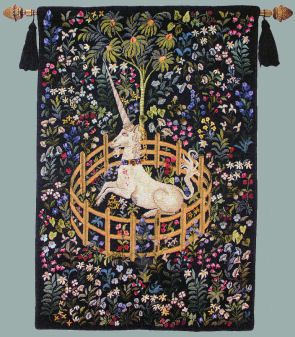
Unicorn in Captivity
24" x 36",
#3-cut wool on burlap
Designed by Pearl McGown
Hooked by Peggy Hannum, Lancaster, Pennsylvania,
1999 |
|
Margaret (Peggy) Hannum
Lancaster, Pennsylvania
Peggy Hannum took
up rug hooking 25 years ago as a diversion from
the demands of her high
school teaching career. Now retired from the
school room, Peggy teaches rug hooking to about 35 students and through
them has learned a great
deal about primitives.
She loves using #3- and #4-cut wool and enjoys dyeing even more than she does
hooking. She is a
historian for the National Guild of Pearl K. McGown
Rug Hookcrafters and has
written numerous articles
for their newsletter. Her
rugs were selected for
three previous editions of
A Celebration of Hand-
Hooked Rugs and have
won, six awards in four
years at the juried Pennsylvania Designer Craftsmen's Annual Gallery
Show. |
|
|
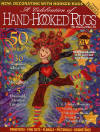
A
Celebration of
Hand-Hooked Rugs XIV
2004
Edition |

(click to enlarge &
read) |
"Istanbul"
Call it kismet or coincidence, but Peggy Hannum says she
was meant to hook Istanbul, a pattern that originated
from a birthday card mailed to Pearl McGown from a
friend who was visiting the Turkish city.
Several years ago, Peggy's rug hooking teacher suggested that
she hook the colorful design. Just hearing the name conjured up
the mysteries and exotic aspects of the Middle East, a part of the
world she and her husband have been traveling to for the past 20
years. "We lived in Jerusalem for three years recently as liaisons for
the United Methodist Church," Peggy says. "We also have visited
Istanbul several times in our travels." Last summer, Peggy's
roommate at the McGown Northern Teachers' Workshop had some
patterns she was disposing of and one of them was
Istanbul.
Peggy
decided right then that she would make this rug her next project.
Peggy found the rug a delight to hook because there were no parts
of the design that were repeated. She sent the
pattern to her workshop teacher, Nancy Blood,
who did the color planning and came up with 16
different 8-value swatches. Peggy loves the
dyeing process almost as much as the actual
hooking so she had a lot of
fun dyeing the
wool and spot dyeing the rug's background. But
as she hooked she found it difficult to hook the
two birds and their mass of feathers. Peggy
found that because there was not much definition
in the 8-value swatches the feathers just seemed
to melt into each other. Then she remembered a
technique taught to her years ago where thread
from a darker piece of wool can be hooked
around each feather. "It's a process that
sounds deadly, but
in fact is easy and fast,"
says Peggy- "One hooks in existing holes and not
in every one, giving the illusion of an edge
without it becoming a definite outline."
Peggy's Istanbul
was an award-winner at the Gallery Show for the Pennsylvania Designer Craftsmen last November including
Best in Show and Excellence in Craftsmanship. The colorful rug is now brightening Peggy's family room, along with many of her
acquisitions from decades of travel and living
in the Middle East. Another bit of proof that
Peggy was meant to hook this rug was
her
chance meeting with the friend who originally
sent Pearl K. McGown the card that inspired
Istanbul. "She still had one of the
cards and has provided me with a color copy of the original," Peggy
remarks. "Now, one of my students is planning to hook the original
colors, I can't wait to help work on the dyeing for this one!"
In
the Judges' Words
"Good control of colors, shows
movement without being busy"
"Incredibly rich and complicated
color scheme-balance is a subtle green"
(go
back up) |

Istanbul,
60" round #3- and #4-cut wool on linen.
Designed by Pearl K. McGown.
Hooked by Peggy Hannum, Lancaster, Pennsylvania,
2003. |
|
Margaret (Peggy) Hannum
Lancaster, Pennsylvania
After 27 years of teaching high school English, Peggy
is now retired and has enjoyed a second career
teaching rug hooking to over 40 students from her home studio. While she
loves hooking rugs, it's dyeing and playing with
color that she calls her "passions." She prefers
fine shading using #3 and #4 cuts and has completed about 25 rugs, pictorials and
many smaller pieces. Peggy is the recipient of numerous awards in the
fiber art and credits rug hooking teachers, Meredith LeBeau and Nancy
Blood, for her more than 25 years of success. This marks Peggy's fifth
appearance in A Celebration of Hand-Hooked Rugs. (See Peggy's beautiful
Lancaster County home decorated with many of
these rugs -
click here to visit this
web page)
|
|
|
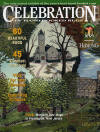
A
Celebration of
Hand-Hooked Rugs XVI
2006
Edition |
"Entice"
When Peggy Hannum
was first introduced to rug hooking by a friend about 30 years ago, she chose as her
very first project a large pattern depicting irises. Her
hooking teacher took one look at the 3' x 4' pattern, gasped, and
gently suggested that most students began with a smaller piece,
perhaps a cushion, and that irises were rather difficult. "She obviously sensed my disappointment and perhaps a bit of a whine when
I replied, 'But I really love irises,'" Peggy-says. "'Then irises it shall
be,' was her reply, and with that began my first dyeing and hooking
instructions, and my love affair with rug hooking, thanks to a gracious and most talented teacher."
Now decades later, Peggy's fondness for flowers has come full
circle---literally. The oval and vivacious Entice is abundant with rich colorful blossoms and is also rather large in size (54" x 61").
She also loved the scrolls in the rug's design and the flouncy tulips
presented a nice challenge for this very experienced and award-
winning rug hooker.
Peggy and one of her teachers at the Maryland Shores
work-
shop, Nancy Blood, planned the colors for the rug. Swatches were
used for the flowers and scrolls, and the rug's background was spot
dyed. "Nancy is a master teacher from whom I have learned so
much over the years," says Peggy. This particular project was no
exception. Nancy taught Peggy how to do the ripples and folds on
the rose and tulip petals. Nancy also suggested that white be added
on the little flowers. Peggy agreed and saw that doing that added
the necessary brightness to the rug. In fact, that touch of light in a
basically dark rug was the most important lesson she learned in
creating this rug. She discovered that the tiny white flowers and fuschias really added the important sparkle needed in this dramatic
design. Peggy also had to redraw the fuschias to be more delicate
and she worked a bit on choosing their colors.
Peggy's Pennsylvania home is filled with her wonderful rugs and
she has now added Entice to the family room. The rug won best in
design at Pennsylvania Designer Craftsmen's juried show and
marks her sixth appearance in A Celebration of Hand-Hooked Rugs.
"I credit whatever skill I have acquired in rug hooking," says Peggy,
"to my excellent teachers, mentors, and friends over the past 30
years, Meredith LeBeau and Nancy Blood."
In
the Judges' Words
"Spectacular!"
"Scrolls and Shading are Magnificent."
"Superb Scrolls."
(go
back up) |
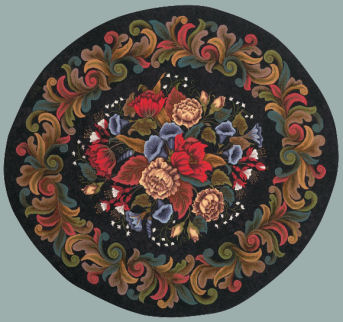
Entice
53"
x 6' oval,
#3-cut wool on linen
Designed by Pearl K. McGown
Hooked by Peggy Hannum, Lancaster, Pennsylvania,
2005 |
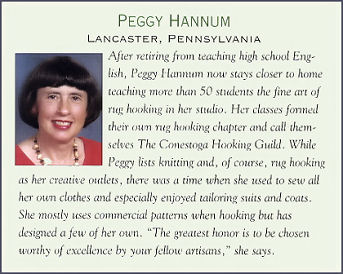 |
|
|
A
Celebration of
Hand-Hooked Rugs
copyright
1991
by The Staff of
RUG HOOKING Magazine |
 |
|

"Wildwood"
Seven feet
by Seven
feet
An Heirloom pattern, #663A
Designed by L. H. Zeiser
Gardening is my first
love. My childhood memories of growing up among the
Amish farms of Lancaster, Pennsylvania, and working with Grandpa in his victory garden, are intertwined with those
outrageous dahlias and first peas. It
isn't surprising that I gain most
pleasure in hooking flowers, fruits
and vegetables.
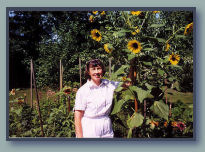 |
"Wildwood"
Mrs. L.H. Zeiser's "Wildwood" captured my imagination as
soon as I saw it pictured in the
Heirloom catalogue, and no less
than a 7' x 7' room-sized rug would
do! Seven years later, off and on
between many other projects, it is
finished and on the floor.
"Wildwood" is a quiet companion
that knows me too well and does
not disappoint. The pinks and
rusts, purple violets and orange
lilies are combinations that surprise
and work.
Ask an addict how it began, and
you might get the same mumbled
replies and furtive evasions: two
closets full of fabrics, bags of yam in
the attic, wardrobes of handmade
clothes, and boxes of hand-knit
sweaters replete with personalized
labels. You are talking to a woman
who cannot walk past a fabric store,
who derives enormous pleasure
from meandering up aisles just feeling fabrics from Boston to Paris
and from Cairo to Damascus.
Fifteen years ago, Marilyn Lovell,
my friend and fellow collector of
bolts and skeins, said she'd just discovered a wondrous new world, full
of wools and mills and, best of all,
dye pots. She was "hooked" and
soon so was I. My next step was to
find a teacher. I must have done
something right in a previous life to
have found Meredith Lebeau. I
arrived in her class with a 4' x 6'
piece of burlap for an "Iris" rug.
Meredith commented that most
students begin more simply with a
"Sue's Rose" cushion, but I naively
said I preferred the irises. That
then, she said, is how you shall
begin. It is still my favorite rug and
has won a blue ribbon in our local
art association show. Hooking is
now part of my life: my relaxation,
my therapy, my way of satisfying the
need to create something subtle,
colorful and tactile.
(go
back up |
|
|
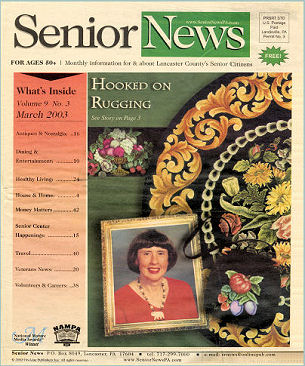 |
"Hooked on Rugging"
by Leslie Hay
Senior News
Volume 9,
Number 3
March 2003
|
|
Peggy Hannum has always enjoyed working with her
hands. She loves gardening, knitting, and
sewing, which is plenty to keep her busy. So
when her good friend Lyn Lovell tried to
interest her in rug hooking, she did not feel
she needed another craft. However, to humor her
friend, Peggy bought a rug hooking kit, and
quite literally, became, "hooked on rug
hooking."
This happened 26 years ago, and her life has taken many twists and
turns, but the path has always led back to rug
hooking. Peggy immediately began taking classes
with veteran teacher, Meredith Le Beau.
She laughingly recalls how innocently she jumped
into this new art. "1 showed up with an iris
pattern that was about 3x4, and Meredith gulped
and said, "We usually suggest that students
begin with something smaller," and 1 wined, "But
I like irises!" and she said, "So irises it must
be!"
Peggy's motto may well be THINK BIG. She completed four rugs in
nineteen years. This may not sound like a lot if
you didn't know that one of them was 7 x 7, and
it took her seven years to finish! Over the
years, Peggy has experimented with a variety of
techniques. "I am always trying new and
different things, even though fine shading
excites me the most. I love colors, I love
dyeing wool, and I love the way it all takes
shape under my fingers."
Several years later, she attended a rug camp with Nancy Blood.
Nancy is renowned for her work with colors. This
has shaped Peggy's outlook as well. "Last year,
I went to Naples, Italy, and was able to observe
closely some wonderful tapestries. I saw that
everything started off as camel- colored wool
and had been dyed, so I decided to try that
myself." She enlisted Nancy's help with the
project, and together they came up with recipes
for dyes. "Everything turned out beautifully,"
she says. "It never really occurred to me, then
or now, to be concerned about doing something to
go in a particular spot in my home. Working with
color has become a way to express myself."
Shortly after her trip, Peggy obtained her teacher's certification.
For about five years she has been instructing
from her Lancaster home. "The experiences 1 have
had shaped the way I teach, but I've never
forgotten that first experience with Meredith.
What a student likes is what they will do - not
necessarily what someone else thinks they ought
to do." She now has over thirty students who
range in age from their twenties to
seventy-plus. They all have different
backgrounds and professions. Peggy delights in
giving them as much individual attention as
possible. She aims to provide her students with
a positive experience and see the craft continue
to be handed down to a new generation.
It's easy to see how much Peggy enjoys teaching and how much
pleasure she gets from passing on her beloved
craft. "I really feel so blessed to have these
wonderful people as my students. And I have seen
lots of lifelong friendships blossom and
flourish in my years of hooking. Everyone is so
willing to share and pass on their love for and
knowledge of the craft."
What's next for this busy Lancaster retiree? Certainly more
teaching and more hooking are in the cards. She
and her husband remain involved with peace and
justice in Middle Eastern countries and
regularly go abroad with different groups
working to bring peace to Israel and Palestine.
Whatever Peggy Hannum's future holds, however,
it's certain that wool and a hook will be part
of the plan.
(go
back up) |
|
|
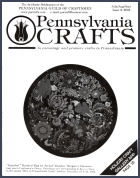
Pennsylvania Guild of
Craftsmen
July/Aug/Sept Issue 3, 2004 |
"Istanbul"
Graces the cover of the 2004 issue on the left
Hooked Rug by Juried Member Margaret Hannum
Last Year's Craftsmen's Choice, Excellence in
Craftsmenship & Best in Show in the annual "Best in
Pennsylvania Crafts" Gallery:
November 27 & 28, 2004 |
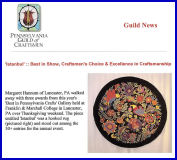 |
|
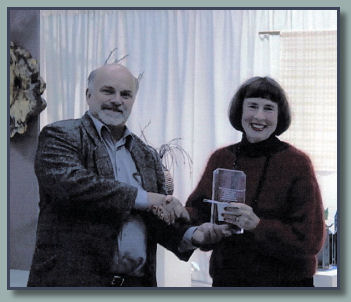
(go
back up) |
|
|
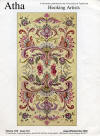
Atha - Association of Traditional
Hooking Artists
Volume
XVII Issue 124 Aug./Sept. 2000 |
"Gainsborough"
When I was introduced to rug hooking twenty
years ago, my first thoughts about the whole
endeavor began with the notion that a rug is a rug,
after all, isn't it? Therefore, if it is to cover a floor
and be walked on, it needs to be sizeable.
Somehow, I suppose that is where my notion of
"big" rugs began. My first rug. Heirloom's "Irises"
was 3' x 5', my second, "Gainsborough",
OSV#440, was 60" round, and as experience
grew, so did my vision of "rug". My third opus
was Heirloom's "Wildwood' which is 7' x 7', and
since it was finished in 1990 has graced our family
room with grandchildren et al, and is holding up
nobly as a "rug" should. What I haven't yet said,
however, is that it took me
seven years to complete
"Wildwood", and that I have a
rather impressive collection of
large unfinished rugs, notably
Heirloom's "Baghdad" and
"Salem" waiting in line while
other large rugs like "Queen
Mary", 3' x 6', have jumped
ahead to the finish line.
When I sit and look at "Gainsborough", which I enjoy doing in odd, spare reflective
moments, what pleases me most
after many hooking years have passed, is the precise detail in
each petal and flower. When I
first began hooking, I was very
fortunate to have found
Meredith LeBeau as my teacher
and mentor. I was teaching high
school English full time, and my
hooking became a wonderful diversion and
relaxing after working my way through stacks of
essays and myriads of lesson plans. I found it
relaxing to spend the whole evening of our weekly
classes doing a few petals of a chrysanthemum.
Now that I have retired and have more time for
hooking, I do not spend years on one rug!
("Gainsborough" was a three year project.)
However, there is perhaps something to
be said about
the slow careful process. I still take pleasure in the
meticulous detail of each turn of a petal in those
chrysanthemums.
I cannot guarantee that the following formulas
for "Gainsborough" will be exact. As we all know,
some of the new Cushing Acid Dyes have
changed. However, I have recently tried to
recreate the gold color in the scrolls for one of my
students. After several bouts with the dye jars, I
can say that the gold formula, which I have
readjusted, is pretty accurate.
(go
back up)
|
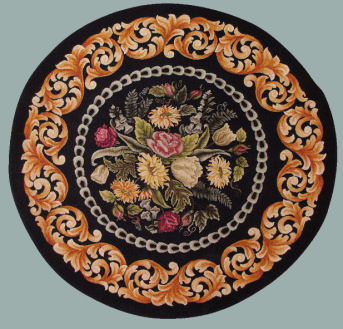
Gainsborough
60" round,
#3-cut wool on burlap
Designed by Pearl K. McGown
Hooked by Peggy Hannum, 1983 |
|
Gold
Scrolls: a lovely soft, clear gold
(Meredith's variation on TOD 28-94 which was too
greenish).
1/8 + 1/16 t. Canary
1 CBW
1/16+1/321 Bright Green
1/16+1/321 Rust
13"xl5" pieces of wool - TOD gradations
Chain, ferns and foxgloves: a
greyed light blue to deep green.
CF 73
Color Flow measurements
Chrysanthemums: M22 (Meredith
LeBeau)
1st color; 1/32 t. Canary in 1/2 CBW
2nd color, 1/8 t. Old Gold in 1/2 CBW
13" x 71/2" pieces of wool - CF
measurements
Also a gold swatch from scrolls intermingled with
M22.
Tulips: very pale green to green: El 80
(Ethel Bruce).
1/4 t. Bronze Green
1/2 CBW
3/32 t. Medium Brown
2/32 t. Nugget Gold
13"xl5" pieces of wool - Measurements:
1/8, 1/4, 72, 3/4, 1, 1-1/2 t., IT, 2T.
Center Rose and buds: a pale blue to greyed rose
E278 (Ethel Bruce)
1st color: 1/16 t. Aqualon Blue - 1/2 CBW
2nd color: 1/8 t. Orchid - 1/2 CBW
3rd color: 1/8 t. Crimson + 1/16 t. Medium
Brown - 1/2 CBW
13"xl5" pieces of wool - CF measurements
Red Roses: almost white to dark red:
TOD 31-102
Greens: TOD 1-3 and
M27 (Meredith LeBeau)
1/2t. Bright Green 1 CBW
3/32 t. Canary
3/32 t. Rust
12"x24" pieces of wool
Connie's measurements for 6 values.
Center of mums and leaf veins: spot dye with
M27, gold and red.
|
|
|
|
|
|

